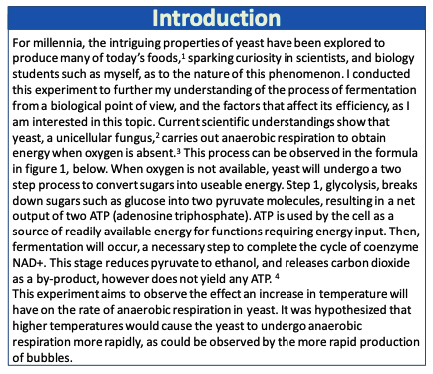VCE Biology Experiment Poster
Summary:
The study, conducted by Jazzy Burke and the team, investigates the effect of temperature on the rate of anaerobic respiration in yeasts. They hypothesized that higher temperatures would increase the speed of anaerobic respiration, observable through the production of bubbles due to the release of carbon dioxide – a byproduct of this process.
Their methodology involved creating two fermenters with identical yeast-sugar solutions but incubated at different temperatures – a control at 30℃ and a test at 45℃. Over a period of 20 minutes, the number of bubbles released per minute was counted and recorded.
The control fermenter began to produce bubbles in the 6th minute, maintaining a rate of 2-3 bubbles per minute for the remainder of the experiment. Conversely, the test fermenter released bubbles in the 3rd minute, with a consistent average of 4-5 bubbles per minute.
The findings demonstrate that an increase in temperature accelerates the rate of anaerobic respiration in yeasts, aligning with their initial hypothesis. However, potential inaccuracies may exist due to inconsistency in bubble size, which could lead to slight errors in measuring the fermentation rate.
Further investigation is suggested to find the optimum temperature for yeast’s anaerobic respiration. The team also recommends refining the experiment by measuring the volume of gas via water displacement in a graduated cylinder, repeating the experiment multiple times for accuracy, and increasing the duration for bubble count.
No ethical considerations were identified for this experiment. It was acknowledged that safety precautions were undertaken throughout the study.
Excerpt:
VCE Biology Experiment Poster
For millennia, the intriguing properties of yeast have been explored to produce many of today’s foods,1 sparking curiosity in scientists, and biology students such as myself, as to the nature of this phenomenon. I conducted this experiment to further my understanding of the process of fermentation from a biological point of view, and the factors that affect its efficiency, as I am interested in this topic. Current scientific understandings show that yeast, a unicellular fungus,2 carries out anaerobic respiration to obtain energy when oxygen is absent.3


Reviews